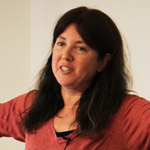Interview with Mehrav Ahissar

b'
This post-lecture interview was conducted during the BCBT Summerschool held at the Universitat Pompeu Fabra, Barcelona, september 2010.\\xa0
With respect to perception, Merav Ahissar (Hebrew University, Israel) wishes to distinguish between the\\xa0 hierarchical direction of signal processing, and the hierarchical direction of explicit perception. In her view, the way we recognize features, items, objects, persons in our environments could be prone to more top down processing than perhaps classically thought. With Paul Verschure she discusses her ideas of a two-way system, in which the processing of a quick, bottom-up estimate of environmental features and global scheme recognition combines with the activation of scheme specific \'pointers\', that offer and induce detailed information stemming from earlier encounters with the world, or training. With respect to how we learn to recognize our environments and its meaningful elements, it is yet unclear how to disambiguate between the strengthening of bottom-up feature recognitions, and top-down pointer generation. With Paul Verschure, Merav Ahissar discusses how to assess such questions experimentally, in both the visual and auditory domain of perception. A recurrent challenge lies in the distinction between recognition at lower, and higher levels: where and how do the top-down and bottom-up directions meet in the recognition processing of seen scenes, objects and persons, as well as of heard tones, words, and semantic meaning.
About the lecturerMehrav Ahissar is Professor at the Department of Psychology of the Hebrew University in Jerusalem. Her research focuses on the perceptual basis of cognitive abilities, auditory perceptual learning, and the perceptual basis of reading and learning disabilities.
'